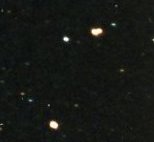
 |
Capricornus's Double or Nothing! Separated by 6.6 minutes of arc, the naked eye "double star" Algedii (toward the upper right) is actually an "optical double" that consists of two unrelated line- of-sight stars, Alpha-1 Capricorni at right, Alpha-2 at left. On the other hand, Dabih (Beta Cap), toward the bottom, is a real, though wide, binary, the pair far enough apart (3.4 minutes of arc) to produce an elongated image, with Beta- 1 (the fainter of the two) a bit down and to the right. The two Alpha stars point down and to the left toward Nu Cap. |